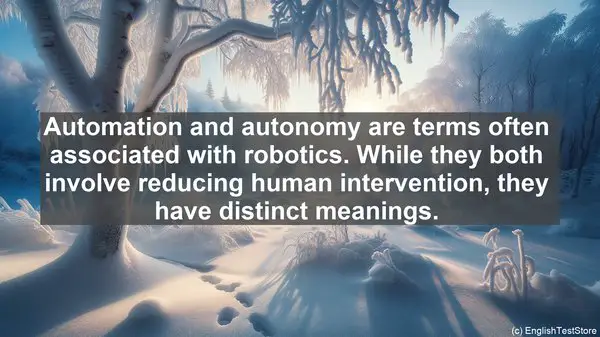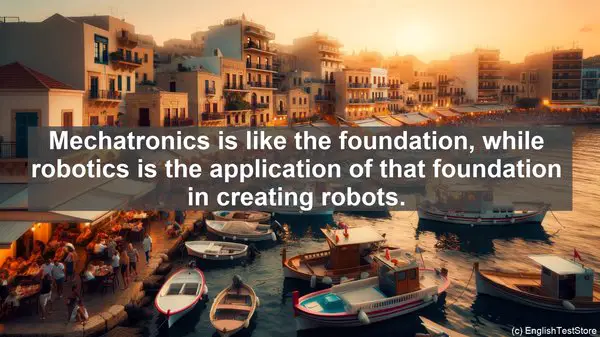Introduction
Welcome to today’s lesson. As you dive deeper into the world of robotics engineering, you may come across certain words that seem similar but have distinct meanings. In this lesson, we’ll explore the top 10 commonly confused words in this fascinating field. Let’s get started!
1. Accuracy vs. Precision
When it comes to measurements, accuracy and precision are often used interchangeably. However, they have different implications. Accuracy refers to how close a measurement is to the true value, while precision refers to the consistency of repeated measurements. In robotics engineering, both are crucial. A robot may be precise in its movements, but if it’s not accurate, it won’t achieve the desired outcome.
2. Automation vs. Autonomy
Automation and autonomy are terms often associated with robotics. While they both involve reducing human intervention, they have distinct meanings. Automation refers to the use of machines to perform tasks that were previously done by humans. On the other hand, autonomy refers to a system’s ability to make decisions and perform tasks without human intervention. In robotics, achieving autonomy is a significant milestone.
3. Actuator vs. Sensor
Actuators and sensors are essential components of a robotic system. An actuator is responsible for converting energy into motion, enabling a robot to perform physical tasks. On the other hand, a sensor detects and measures changes in the environment, providing input to the robot’s control system. In simple terms, an actuator allows a robot to interact with the world, while a sensor allows it to perceive the world.
4. Algorithm vs. Program
In the realm of robotics, algorithms and programs are often used in conjunction. An algorithm is a step-by-step procedure or set of rules for solving a specific problem. It’s the logic behind the solution. A program, on the other hand, is the implementation of that logic in a programming language. Think of the algorithm as the recipe, and the program as the dish prepared using that recipe.
5. Kinematics vs. Dynamics
When studying the motion of robots, you’ll encounter the terms kinematics and dynamics. Kinematics focuses on the geometry and motion of objects without considering the forces involved. It’s like studying the path a robot takes. Dynamics, on the other hand, considers the forces and torques that affect the motion. It’s like studying the factors that influence how the robot moves along that path.
6. Localization vs. Mapping
Localization and mapping are crucial for a robot to navigate and understand its environment. Localization refers to the robot’s ability to determine its own position relative to a known map. It’s like a GPS for robots. Mapping, on the other hand, involves creating a map of the environment, often done simultaneously with localization. It’s like the robot’s mental model of its surroundings.

7. Haptic vs. Tactile
Haptic and tactile are terms related to the sense of touch. Haptic refers to the perception of touch through forces, vibrations, or motions. It’s like the feedback you get when using a game controller with vibration. Tactile, on the other hand, refers to the perception of touch through direct contact. It’s like feeling the texture of an object with your hand. Both are important for robots interacting with the physical world.

8. Mechatronics vs. Robotics
Mechatronics and robotics are interdisciplinary fields that overlap in many areas. Mechatronics combines mechanical engineering, electronics, and control systems. It focuses on the design and integration of smart systems. Robotics, on the other hand, specifically deals with the design, construction, and operation of robots. Mechatronics is like the foundation, while robotics is the application of that foundation in creating robots.
9. Feedback vs. Feedforward
Feedback and feedforward are two approaches to control systems in robotics. Feedback control involves continuously measuring the output and comparing it to the desired value, making adjustments based on the error. It’s like a thermostat maintaining a set temperature. Feedforward control, on the other hand, anticipates the required adjustments based on known inputs. It’s like a robot adjusting its movements based on the terrain it’s about to encounter.
10. Manipulator vs. Mobile Robot
When it comes to robots, there are different types. A manipulator, also known as a robotic arm, is designed for precise movements and manipulation of objects. It’s like the arm of a factory robot. A mobile robot, on the other hand, is designed for locomotion and navigation in an environment. It’s like a robot vacuum cleaner. Both have their unique applications and challenges.
